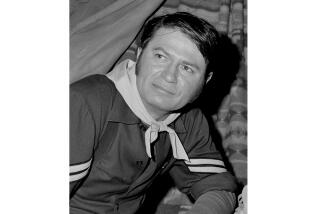Herbert L. Strock, 87; Creature Feature Director, Pioneering TV Producer
- Share via
Herbert L. Strock, a pioneer television producer and director who also directed the B-movie creature features “I Was a Teenage Frankenstein,” “How to Make a Monster” and “The Crawling Hand,” has died. He was 87.
Strock died Wednesday of heart failure at Riverside County Regional Medical Center in Moreno Valley after a car accident, his daughter, Leslie Mitchner, said.
Strock launched his television directing career in the late 1940s and worked on countless series, directing the first 10 episodes of “Highway Patrol” and episodes of “Sky King,” “Sea Hunt,” “Maverick” and “77 Sunset Strip.”
But he is best remembered for his drive-in movie fare, which included “Blood of Dracula” and “Gog,” shot in 3-D.
“He was just a real old-time type of get-it-down Hollywood moviemaker, who’d just go in knowing what needed to be done and very efficiently handling everything,” said Tom Weaver, a horror and science fiction film expert who interviewed Strock for Fangoria magazine. “He always turned the stuff out within schedule and budget, which made him the producer’s darling.”
Born in Boston, Strock moved with his family to Los Angeles when he was 13. At 17, while still a student at Beverly Hills High School, he became the director of gossip columnist Jimmy Fidler’s Hollywood segments for Fox Movietone News, in which Fidler visited with stars.
A 1941 graduate of USC, where he studied journalism and film, Strock served a brief stint in the Army’s Ordnance Motion Picture Division before landing a job at MGM as an assistant editor on the 1944 film “Gaslight.”
Several years later, he became a television pioneer as the producer and director of 13 episodes of “The Cases of Eddie Drake,” a half-hour filmed detective series starring Don Haggerty and Patricia Morison. Although made for CBS, it aired years later on the DuMont network.
“It was the first television show ever put on film,” Strock said in an interview with Weaver. “We shot it in 35-millimeter black and white. My budget was $7,500 per half hour, and we shot one a day. This was unheard of in Hollywood. I would shoot four pictures in a batch, all mixed up, in four days.”
The story in each episode was set up by having detective Haggerty go to crime psychologist Morison’s office to tell her what had happened.
During the filming of the series, Morison recalled Friday, she learned she had gotten the female starring role in Cole Porter’s “Kiss Me, Kate” on Broadway.
After telling Strock that she would have to fly to New York to begin rehearsals, she recalled:
“He said, ‘Oh, this is so exciting. We’ll rearrange our schedule and shoot all your segments in 10 days.’ He didn’t give any argument. That’s what I remember about him: how generous he was.”
Strock made his transition to feature film directing when, as associate producer and film editor, he took over as the uncredited director of the 1953 science-fiction thriller “The Magnetic Monster.” He also took over as the uncredited director of the 1953 science-fiction horror film “Donovan’s Brain,” whose cast included Nancy Davis Reagan.
Strock, who owned a post-production facility after he quit directing in 1980, wrote about his career in the 2000 book “Picture Perfect,” part of the Scarecrow Filmmakers Series.
In addition to his daughter Leslie, he is survived by his wife of 64 years, Geraldine; daughters Candice Dell Strock and Genoa Dodd; and two grandsons.
A private memorial service will be held.
More to Read
The biggest entertainment stories
Get our big stories about Hollywood, film, television, music, arts, culture and more right in your inbox as soon as they publish.
You may occasionally receive promotional content from the Los Angeles Times.









